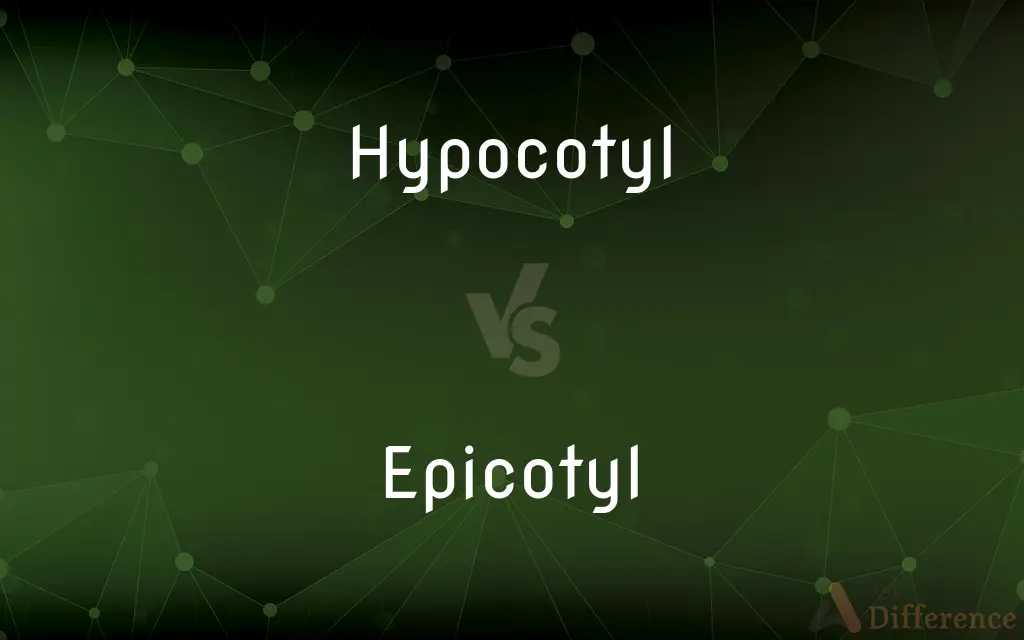Hypocotyl vs. Epicotyl — What's the Difference?
By Tayyaba Rehman & Maham Liaqat — Updated on March 21, 2024
Hypocotyl is the stem-like part of a seedling below the cotyledons, connecting root and shoot, while epicotyl is above the cotyledons, leading to the first true leaves.

Difference Between Hypocotyl and Epicotyl
Table of Contents
ADVERTISEMENT
Key Differences
Hypocotyls are part of a seedling that extends from the root system to the base of the cotyledons, functioning primarily in the initial stages of germination to support the seedling. It acts as a critical component in establishing the young plant's connection to the soil and in the elongation process during germination. On the other hand, the epicotyl is located above the cotyledons and extends up to the first true leaves of the plant. Its main function is to support the development and growth of the aerial parts of the plant, including leaves and, eventually, the stem.
The hypocotyl plays a significant role in the early life of a seedling, especially in dicots, where it often elongates to push the cotyledons above the soil surface, ensuring that the photosynthetic apparatus is exposed to light. This process is known as hypocotyl elongation and is critical for the survival of the plant. Whereas the epicotyl's growth is crucial for the subsequent development of the plant, as it gives rise to the primary stem that will bear the plant's leaves, flowers, and fruits in its lifetime.
In terms of location and function, the hypocotyl is seen as the transition zone between the root and the aerial parts of the plant, providing stability and support as the seedling emerges from the soil. In contrast, the epicotyl is considered the initial segment of the shoot system, leading the way in the plant's upward growth and development towards the light source, which is essential for photosynthesis.
The development and growth rates of the hypocotyl and epicotyl can vary significantly among plant species, influenced by environmental factors such as light, temperature, and moisture. The hypocotyl is particularly responsive to light quality, with certain wavelengths promoting its elongation, a phenomenon that helps seedlings emerge from soil or debris. Meanwhile, the epicotyl's growth rate is closely tied to the availability of light and nutrients, as these resources are vital for the development of leaves and the overall photosynthetic capacity of the plant.
Understanding the distinctions between hypocotyl and epicotyl is essential in botany and horticulture, as these parts play critical roles in the germination, early growth, and development of plants. By studying these components, researchers and gardeners can better understand plant growth patterns, improve cultivation techniques, and address challenges in plant development.
ADVERTISEMENT
Comparison Chart
Location
Below the cotyledons, connecting root and shoot.
Above the cotyledons, leading to the first true leaves.
Function
Supports seedling and connects the root system to aerial parts.
Supports the development of aerial parts, including leaves and stem.
Role in Germination
Often elongates to push cotyledons above soil for photosynthesis.
Develops after cotyledons, contributing to the plant's primary stem and leaf growth.
Environmental Response
Responsive to light quality, influencing elongation for seedling emergence.
Growth rate influenced by light and nutrients for photosynthetic development.
Importance
Critical for early stability and support of the seedling.
Essential for the plant's subsequent aerial development and photosynthesis.
Compare with Definitions
Hypocotyl
The part of a seedling that extends from the root to the cotyledons, functioning in seedling support.
The hypocotyl elongates rapidly in bean seedlings, pushing the cotyledons out of the soil.
Epicotyl
The segment of a seedling above the cotyledons, leading to the development of true leaves.
The epicotyl's growth is evident as the seedling begins to form its first true leaves above the cotyledons.
Hypocotyl
Acts as a transitional zone between root and shoot in young plants.
In many dicots, the hypocotyl is clearly visible as the seedling emerges from the ground.
Epicotyl
Functions primarily in the growth and development of the plant's aerial parts.
As the epicotyl elongates, it forms the primary stem that will later bear leaves and flowers.
Hypocotyl
Responsive to environmental cues such as light and gravity.
The direction and rate of hypocotyl growth can change in response to light direction, illustrating phototropism.
Epicotyl
Determines the plant's capacity for photosynthesis in early stages.
The leaves that emerge from the epicotyl's growth are crucial for the plant's photosynthetic efficiency.
Hypocotyl
Essential for the early development and survival of seedlings.
The strength and growth rate of the hypocotyl can determine the seedling's ability to survive and thrive.
Epicotyl
Influenced by light, playing a role in the plant's orientation towards the light source.
The epicotyl exhibits positive phototropism, growing towards light to maximize photosynthesis.
Hypocotyl
Plays a crucial role in germination, especially in dicots.
The hypocotyl's elongation is vital for exposing the cotyledons to light, enabling photosynthesis.
Epicotyl
Critical for the subsequent phases of plant growth and development.
The development of the epicotyl is a key phase in transitioning from a seedling to a mature plant.
Hypocotyl
The hypocotyl (short for "hypocotyledonous stem", meaning "below seed leaf") is the stem of a germinating seedling, found below the cotyledons (seed leaves) and above the radicle (root).
Epicotyl
An epicotyl is important for the beginning stages of a plant's life. It is the region of a seedling stem above the stalks of the seed leaves of an embryo plant.
Hypocotyl
The part of a plant embryo or seedling plant that is between the cotyledons and the radicle or root.
Epicotyl
The stem of a seedling or embryo located between the cotyledons and the first true leaves.
Hypocotyl
(botany) In plants with seeds, that portion of the embryo or seedling between the root and cotyledons.
Epicotyl
(botany) In plants with seeds, that portion of the embryo or seedling above the cotyledons.
Common Curiosities
What is the epicotyl?
The epicotyl is the segment of a seedling located above the cotyledons, leading to the first true leaves and contributing to aerial development.
What role does the epicotyl play in plant growth?
The epicotyl supports the development of the plant's aerial parts, including leaves and stems, essential for photosynthesis and further growth.
How do the hypocotyl and epicotyl differ in their response to light?
The hypocotyl responds to light quality, promoting elongation to emerge from soil, while the epicotyl grows towards light sources to optimize photosynthesis.
Is the hypocotyl present in all plants?
The hypocotyl is present in seed-bearing plants, especially noticeable in dicots, but its prominence and function can vary among different plant species.
Can the epicotyl be distinguished from the hypocotyl in all seedlings?
In many seedlings, especially dicots, the epicotyl and hypocotyl are distinctly visible, but their prominence can vary, making them more or less distinguishable.
Why is it important to differentiate between the hypocotyl and epicotyl when studying plant development?
Differentiating between the hypocotyl and epicotyl is important for understanding their distinct roles in plant germination, growth, and development, which is essential for botanical research and agricultural practices.
How does the hypocotyl function in germination?
During germination, the hypocotyl often elongates to push the cotyledons above the soil surface, allowing for light exposure and the beginning of photosynthesis.
Can environmental factors affect hypocotyl and epicotyl growth?
Yes, factors such as light quality, temperature, and moisture can significantly influence the growth and development rates of both the hypocotyl and epicotyl.
Does the length of the hypocotyl affect a plant's survival?
Yes, the length of the hypocotyl can affect a plant's ability to reach the soil surface and access light, which is crucial for its survival and further growth.
What is the hypocotyl?
The hypocotyl is the part of a seedling that extends from the root system to the base of the cotyledons, providing support during early growth.
What is the importance of studying hypocotyl and epicotyl in plants?
Understanding these parts is crucial for botany and horticulture, as it helps in improving plant cultivation techniques and addressing growth challenges.
Are there any specific techniques to enhance the growth of the hypocotyl or epicotyl?
Techniques such as controlling light exposure, temperature, and moisture levels can enhance the growth and development of both the hypocotyl and epicotyl, depending on the specific needs of the plant.
How do temperature and moisture affect the growth of the hypocotyl and epicotyl?
Temperature and moisture can significantly affect the growth rates of both the hypocotyl and epicotyl, with optimal conditions promoting faster and healthier development.
What happens to the hypocotyl and epicotyl as the plant matures?
As the plant matures, the hypocotyl becomes part of the stem structure, while the epicotyl develops into the primary stem that bears leaves and possibly flowers.
Share Your Discovery

Previous Comparison
Loan vs. Bond
Next Comparison
Pig vs. PandaAuthor Spotlight
Written by
Tayyaba RehmanTayyaba Rehman is a distinguished writer, currently serving as a primary contributor to askdifference.com. As a researcher in semantics and etymology, Tayyaba's passion for the complexity of languages and their distinctions has found a perfect home on the platform. Tayyaba delves into the intricacies of language, distinguishing between commonly confused words and phrases, thereby providing clarity for readers worldwide.
Co-written by
Maham Liaqat













































